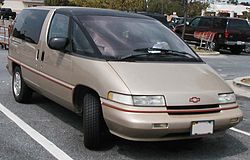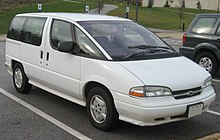Chevrolet Lumina APV
| Chevrolet | |
|---|---|
|
Chevrolet Lumina APV (1990-1994)
|
|
| Lumina APV | |
| Production period: | 1990-1996 |
| Class : | Van |
| Body versions : | Station wagon |
| Engines: |
Petrol engines : 3.1-3.8 liters (90-134 kW) |
| Length: | 4933 mm |
| Width: | 1877 mm |
| Height: | 1656-1669 mm |
| Wheelbase : | 2789 mm |
| Empty weight : | 1632-1769 kg |
| successor | Chevrolet Venture |
The Chevrolet Lumina APV was a van manufactured by Chevrolet, a GM division , between 1990 and 1996 model years. The sister models of the Lumina APV were the Pontiac Trans Sport and the Oldsmobile Silhouette .
background
General Motors' first attempt to build a van to compete with the Dodge Caravan and Plymouth Voyager , the Chevrolet Astro and its twin GMC Safari , failed to add to Chrysler's almost complete domination of the van market in the late 1980s change, you started a second attempt. The Lumina APV was released as part of a planned complete Lumina series , which then actually only consisted of a sedan and this van. APV stands for "All Purpose Vehicle". The car itself was versatile and showed some technical innovations, but the unusual "spacey" exterior could not convince the van customers.
Technology and innovations
The cars were assembled in the now closed GM plant in Tarrytown (New York) and were based on the GM-U platform, which consisted of a galvanized steel framework ( "space frame " ) combined with GRP body parts that were resistant against rust and minor damage. This manufacturing technology was developed for the Pontiac Fiero and was used extensively by GM for the products of its Saturn division . The vehicle also shared components with the GM-A - platform .
The Lumina APV was available as a seven-seater, with the five rear seats light (15.4 kg) and freely combinable in the cargo area. From 1994 on there were permanently installed child seats, which opened up the possibility of converting two of the rear seats from adult to child seats with one pull on an attached lever.
The Lumina APV was the only one of the three sister models that was also available as a delivery van. It had rubber mats instead of carpets, no rear seats and painted plastic inserts in place of the rear side windows.
On request, the cars were equipped with a level control system consisting of inflatable shock absorbers at the rear and a small compressor. In this way, the wagons could be adjusted to the correct level regardless of the load. In addition, a tube supplied made it possible to inflate the tires or sports and play equipment.
First a 3.1-liter V6 engine was used, which delivered a maximum output of 120 hp (90 kW) and was rated as appropriate by the press.
In the 1992 model year, the Lumina APV and its sister models also got a 3.8-liter V6 engine from Buick with a maximum output of 170 hp (127 kW). This engine developed a significantly higher torque and accelerated the cars better, which made them the best-powered vans of their time until the Ford Windstar with its maximum 200 hp (149 kW) 3.8-liter V6 engine came out in model year 1996 .
From the 1994 model year, there were remote-controlled, electric sliding doors.
In the 1994 and 1995 model years, traction control was available along with the 3.8-liter V6 engine.
Sales success
The design of these vans has been very controversial. When the Chevrolet Lumina APV and its sister models were designed, no one had tried marketing sporty vans, but GM thought this could become a large segment of the market. The vans were designed to be lower and slimmer than any comparable car from other brands in this market. The long, gently sloping windshield and the resulting large distance to its lower edge made for an unusual driving experience until the driver got used to the changed dimensions. Auto magazines called the new vans "Dustbusters" because of their typical side view.
In response to buyers' criticism of the avant-garde styling of the vehicles (and annual production figures that were about 50% below the 150,000–200,000 vehicles expected by General Motors by 1992), reviews of potential buyers, publications in motor magazines and even Maliciousness in Chrysler's commercials, the decision was made in 1994 to give the Lumina APV and Trans Sport a facelift . The nose was shortened by 3 ″ (75 mm) and the A-pillars were no longer painted black to give the car a more conventional look. In addition, there was an edge on the inside of the dashboard to reduce the visible distance to the lower edge of the windshield.
End of production
Production of these vans ceased in 1996 and the Tarrytown plant, which had existed since 1900, was closed and demolished.
The Lumina APV has been replaced by the Venture , a brand new vehicle with a conventional steel frame monocoque and ordinary styling.
Year by year
1991
- Customer complaints about reflections from the enormous dashboard in the windshield lead to the installation of a black carpet on the dashboard instead of the previous plastic surface.
1992
- This year the Buick 3.8-liter V6 engine with 127 kW was new to the range in conjunction with an electronically controlled, four- speed automatic transmission 4T60-E.
- The radio antenna mast mounted in the area of the bulkhead disappeared and was replaced by a roof antenna between the tin roof and the headliner.
- The fixed rear-view mirrors were exchanged for movable ones, which were also bigger.
- The brakes have been enlarged and fitted with ABS as standard .
1993
- A remote-controlled, electric sliding door was announced, but it was not produced until the following year.
- A revised center console with larger switches for the air conditioning and large shelves has been added.
1994
- The styling of the cars was revised and the nose was shortened by 75 mm, the headlights of the Pontiac Bonneville were used and the A-pillars were no longer painted black but in the body color so that the cars looked more similar to competing products.
- To make the distance between the dashboard edge and the lower edge of the windshield appear smaller, the dashboard was provided with an additional edge.
- The electric sliding door (see 1993) was introduced into production as an extra.
- Built-in child seats in the second row of seats were available on request.
- Traction control was also available on request.
- The darkened rear windows were colored even more strongly.
- An airbag on the driver's side became standard.
1995
- Electric door locks that unlock with the parking function of the automatic transmission and lock automatically with any other position of the selector lever have been introduced as a standard function in the optionally available door lock package.
1996
- Last year of production. The APV was replaced by the Venture .
- The 3.1-l and 3.8-l V6 engines fell out of production, the 3.4-l V6 engine with 180 hp (134 kW) maximum output and a maximum torque of 277 Nm to the only available engine.
- The traction control was no longer available.
Web links
literature
Dan McCosh: GM's New-Plastic Technology Van . In: Popular Science . June 1989. Bonnier Corporation, June 1989, ISSN 0161-7370 , p. 115-119, 151 ( google.com ).
Individual evidence
- ↑ Jim Mateja: 1990 Chevrolet Lumina APV - chicagotribune.com Review | Cars.com. In: cars.com. September 3, 1989, accessed November 30, 2018 .
- ↑ 1990 Chevrolet (USA) Lumina APV full range specs. In: automobile-catalog.com. Retrieved November 30, 2018 .
- ^ Richard Truett: 1990 Chevrolet Lumina APV - Orlando Sentinel Review | Cars.com. In: cars.com. March 29, 1990, accessed November 30, 2018 .
- ↑ 1992 Chevrolet (USA) Lumina APV full range specs. In: automobile-catalog.com. Retrieved November 30, 2018 .
- ↑ Doron P. Llevin: Vehicle's Design Doomed Van Plant - The New York Times. In: nytimes.com. February 26, 1992, accessed November 30, 2018 .
- ↑ Jim Mateja: undefined Chevrolet Lumina APV - chicagotribune.com Review | Cars.com. In: cars.com. October 24, 1993, accessed November 30, 2018 .
- ↑ John A. Russel: AFTER 100 YEARS, 12 MILLION CARS, VENERABLE TARRYTOWN TURNS TO DUST. In: autonews.com. July 12, 1999. Retrieved November 30, 2018 (American English).
- ↑ 1990-96 Chevrolet Lumina APV / Minivan | Consumer Guide Auto. In: consumerguide.com. Retrieved November 30, 2018 (American English).
- ↑ 1996 Chevrolet (USA) Lumina APV full range specs. In: automobile-catalog.com. Retrieved November 30, 2018 .


